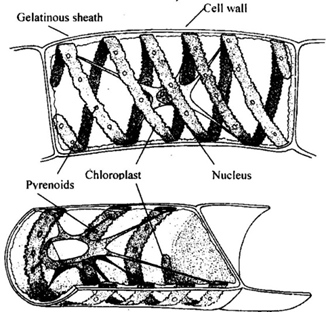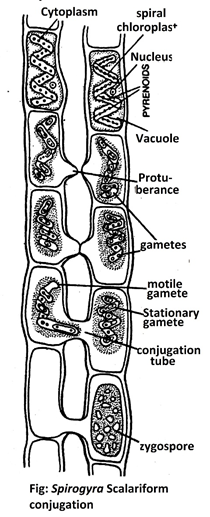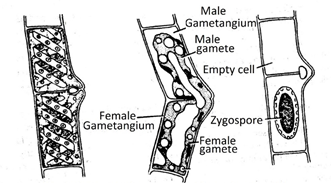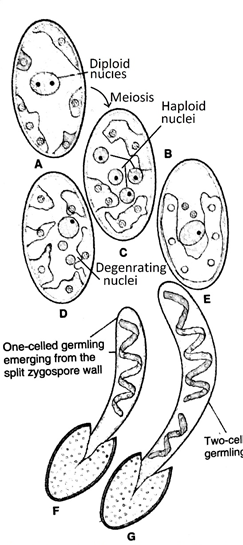Division : Chlorophyta
Class : Chlorophyceae
Order : Conjugates
Sub-order : Zygnemoideae
Family : Zygnemaceae
Genus : Spirogyra
OCCURRENCE
Spirogyra (Gr. Speira, a coil, Gr. Gyros, twisted) is a large genus. It is found throughout the world in fresh water. Its filaments look like a shining silky mass in running water. That is why it is also called “water-silk”, “pond scum” or “mermaid’s tresses”.

Fig: Spirogyra Cell structure
VEGETATIVE STRUCTURE:
The plant body is filamentous, the filaments are green, simple, unbranched. A filament is a single row of cylindrical cells. The filaments are free floating. A few species remain attached to the substrata with the help of hapteron or holdfast.
CELL STRUCTURE:
The cells are generally more in length than in breath.
- Cell wall: Cell wall is composed of two layers. The outer is pectic and inner layer is composed of cellulose. The pectin of outermost layer dissolves in water and forms a slimy mucilaginous sheath.
- Protoplast: Their protoplast is differentiated into structures such as plasma membrane, chloroplast, pyrenoid, a large central vacuole other cytoplasmic organelles and nucleus.
- a) Nucleus: The nucleus is present in the centre. It is suspended by strands of cytoplasm. b) Cytoplasm: The cytoplasm is peripheral due to large central vacuole. Cytoplasm is traversed by several cytoplasmic strands.
- c) Chloroplasts: These are ribbon-shaped and arranged spirally hence alga named as Spirogyra. The chloroplast contains many Each pyrenoid consists of a central proteinaceous core surrounded by many small starch plates.
REPRODUCTION:
Reproduction in Spirogyra is vegetative and sexual. However, some species reproduce asexually through akinetes and aplanospore formation.
- Vegetative Reproduction:
Fragmentation during favourable conditions, the filaments break into two or more fragments, each or which develop into a new filament.
- Sexual Reproduction:
Sexual reproduction is isogamous type and takes palace under unfavourable conditions. The conjugation may be of following types.
Scalariform conjugation:
It takes place between the cells of two different filaments. The filaments lie side by side or parallel to one another, through their length.
- Any cell of filament can acts as gametangium and produces a single gamete.
- The gamete producing cells are opposite to each other in both filaments.
- These cells develop lateral outgrowths, which soon meet by their tips.
- The walls dissolve and a conjugation tube is formed between gametangia.
- The cell contents are changed into a single gamete. Motile gamete is male non-motile is female

Fig: conjugation in Spirogyra
Fertilization:
- One gamete passes through the conjugation tube and reaches the opposite cell.
- It fuses with the gametes of the other filament.
- Zygote (2n) is formed in one cell. The other stands remain empty.
(B) Lateral conjugation
- It takes place between the two adjacent cells of the same filament.
- The upper cell functions as male gametangium and remains smaller. Its contents are transformed to single male gamete.
- The lower cell acts as female gametangium.It increases in size and its contents are transformed to female gamete or egg.
- The protoplast of male cell forms an outgrowth.
- An opening is formed in the wall and the contents of male cell pass into the female cell where fertilization takes place and zygote (2n) is formed.

Fig: Spirogyra, various stages of lateral conjugation
ZYGOSPORE
- Zygote is converted into zygospore by developing a 3 layered thick wall.
- The outer two layers of gametangial wall burst and the zygospore comes out.
- After a period of rest zygospore divides meiotically.
- One out of four nuclei germinate to produce a haploid plant, the rest are disintegrate.

Fig: Zygospore germination